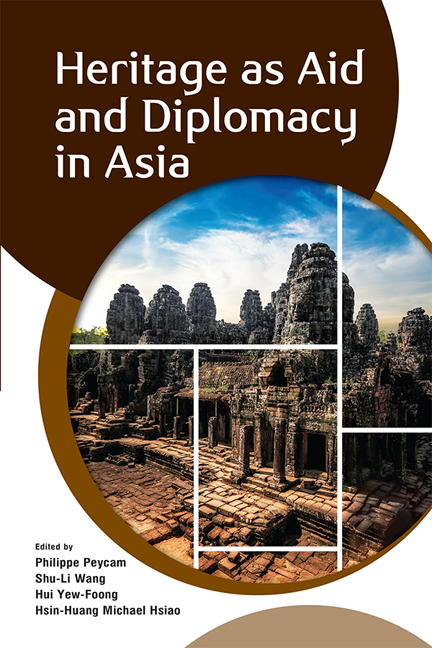Book contents
- Frontmatter
- Contents
- Contributors
- 1 Heritage as Aid and Diplomacy in Asia: An Introduction
- 2 World Heritage and WikiLeaks: Territory, Trade and Temples on the Thai-Cambodian Border
- 3 Heritage Making – Aid For Whom? The Genealogy of Expert Reports in the Hands of Politics and Their Impact in the Case of Preah Vihear
- 4 The International Coordinating Committee for Angkor: A World Heritage Site as an Arena of Competition, Connivance and State(s) Legitimation
- 5 Legacies of Cultural Philanthropy in Asia
- 6 To Help or Make Chaos? An Ethnography of Dutch Expertise in Postcolonial Indonesia
- 7 Heritage Conservation as a Tool for Cultural Diplomacy: Implications for the Sino-Japanese Relationship
- 8 From Ideological Alliance to Identity Clash: The Historical Origin of the Sino-Korean Goguryeo Controversies
- 9 Nationalism, Politics and the Practice of Archaeology in Afghanistan: A Case Study of Bamiyan
- 10 Disappearing Voices: The Politics and Practice of Safeguarding Kunqu Opera in the People’s Republic of China
- 11 Neoliberalizing Heritage: International Agencies and the Local Dynamics of Heritage Conservation in Bali, Indonesia
- 12 Heritage Conservation as Trickle-Down Development
- Index
7 - Heritage Conservation as a Tool for Cultural Diplomacy: Implications for the Sino-Japanese Relationship
Published online by Cambridge University Press: 10 November 2020
- Frontmatter
- Contents
- Contributors
- 1 Heritage as Aid and Diplomacy in Asia: An Introduction
- 2 World Heritage and WikiLeaks: Territory, Trade and Temples on the Thai-Cambodian Border
- 3 Heritage Making – Aid For Whom? The Genealogy of Expert Reports in the Hands of Politics and Their Impact in the Case of Preah Vihear
- 4 The International Coordinating Committee for Angkor: A World Heritage Site as an Arena of Competition, Connivance and State(s) Legitimation
- 5 Legacies of Cultural Philanthropy in Asia
- 6 To Help or Make Chaos? An Ethnography of Dutch Expertise in Postcolonial Indonesia
- 7 Heritage Conservation as a Tool for Cultural Diplomacy: Implications for the Sino-Japanese Relationship
- 8 From Ideological Alliance to Identity Clash: The Historical Origin of the Sino-Korean Goguryeo Controversies
- 9 Nationalism, Politics and the Practice of Archaeology in Afghanistan: A Case Study of Bamiyan
- 10 Disappearing Voices: The Politics and Practice of Safeguarding Kunqu Opera in the People’s Republic of China
- 11 Neoliberalizing Heritage: International Agencies and the Local Dynamics of Heritage Conservation in Bali, Indonesia
- 12 Heritage Conservation as Trickle-Down Development
- Index
Summary
The Sino-Japanese relationship has experienced ups and downs since its diplomatic normalization in the 1970s. The increasing economic interdependence has broadened and deepened mutual understanding and interests among business sectors and the general public in both countries, while historical problems, security and territorial disputes, and economic competition remain the main obstacles for building trust and confidence between the two governments. The bilateral relationship since the changes in leadership in the two countries in 2012 has substantially deteriorated. Chinese President Xi Jinping and Japanese Prime Minister Abe Shinzō were finally able to schedule their first bilateral summit in 2014, at the Beijing APEC Leaders’ Summit, after they had both been in office for two years. It is expected that the Sino-Japanese relationship will continue to face many challenges, particularly in relation to security issues.
With such a pessimistic background to Sino-Japanese relations over the past few years, this chapter aims to examine how heritage conservation could operate as a tool of cultural diplomacy in the context of Sino-Japanese confrontation. Heritage not only contains cultural or historical value but also enhances and channels a national image to a country's people, and to the rest of the world. So, in order to realize the nationalist agenda, it is essential for both governments to “push” heritage conservation at the international institutional level—in this case, through the framework of the United Nations Educational, Scientific and Cultural Organization (UNESCO). The core concern of this chapter is to explore how China and Japan interact with different stakeholders through the negotiation and lobbying processes to realize their cultural and diplomatic, or nationalistic objectives.
The chapter consists of five sections. After this introduction, the second section reviews the process of heritage conservation at the domestic and international levels. I apply a constructivist approach to conceptualize heritage as a tool of cultural diplomacy. The third and fourth sections delineate two case studies related to heritage conservation and the Sino- Japanese relationship: (1) the inclusion of sites of Japan's Meiji Industrial Revolution: Iron and Steel, Shipbuilding and Coal Mining in the World Heritage List (WHL); and (2) the inclusion of Documents of the Nanjing Massacre in the Memory of the World Register (MWR) in July and October 2015, respectively.
- Type
- Chapter
- Information
- Heritage as Aid and Diplomacy in Asia , pp. 167 - 189Publisher: ISEAS–Yusof Ishak InstitutePrint publication year: 2020



